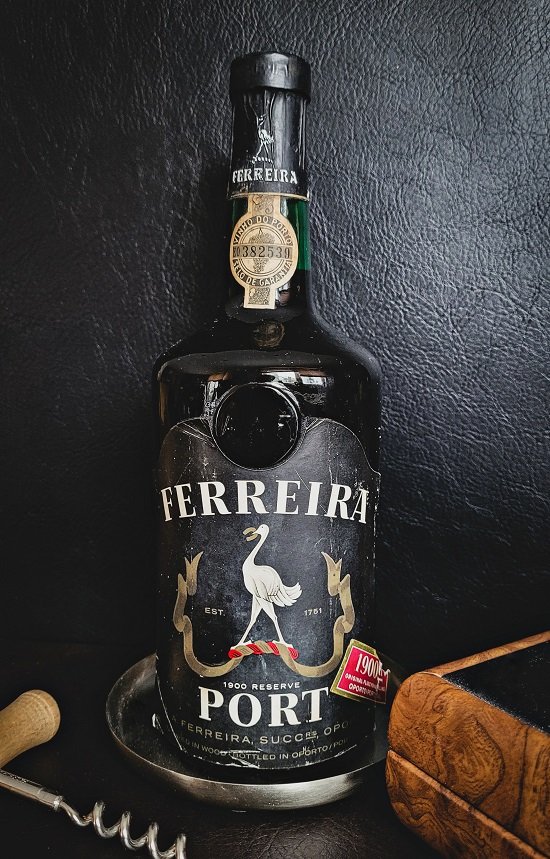Ferreira 1900-1972 Reserve Port
Origin: Portugal / ?% (not specified) / Price: ca. 1000€+
Even though Ferreira Port is relatively lesser known in Germany, where Niepoort, the British Graham's and Taylor's and the also quite historically important Royal Oporto are more popular, the house can and must be counted among the core pillars of the Portuguese world of port wine. In Portugal, Ferreira is actually the no. 1 in consumption and also in many ratings. It is one of the world's largest Port exporters, with over 300 hectares of its own vineyards. However, Ferreira has also made several historical contributions to the Port industry and has produced some influential personalities. This is not to repeat the claims of history from the producers themselves, but to give you an idea of the long history and circumstances in which this port was made.
The mentioned personalities include, in particular, Dona Antónia Ferreira, also affectionately known locally in the Douro Valley as “Ferreirinha”. The great-granddaughter of the company founder is regarded as a kind of national saint. In a 2007 poll organized by public television station RTP to find the “Greatest Portuguese of all time”, she was voted 39th. How did she manage this, over 110 years after her death in 1896?
When she lost her husband, the chairman of the Ferreira House, at just 33, she moved with her young daughter to the rugged region of the upper Douro. She took over her husband's company and, with great business acumen, a remarkable pioneering spirit and, above all, an exceptionally strong social conscience, led it to the top of all port wine houses, which at the time still largely produced traditional wines.
She modernized the port wine production process, created new port wines, expanded wine growing and campaigned against the neglect of port wine production by politicians. Under her leadership, Ferreira achieved worldwide renown, particularly as a result of the extensive exports to the United Kingdom. She significantly increased the family fortune. At the same time, she developed charitable activities in her home region and helped set up hospitals, schools, and kindergartens.
A historic Ferreira advertisement
Today we are tasting a 1900 Reserve from Ferreira, bottled in 1972, an absolutely wonderful and special occasion. When it comes to port wine, it is sometimes not so easy to categorize very old bottlings. Even people with much more port experience than myself had to re-sort their own thoughts when categorizing one or two old bottles that I sent them photos of. “Reserve” is no longer used in this sense, just like some other old terms. Here we have a single vintage port, so to speak, but it is stored and produced like a tawny, not to be confused with actual “Vintage Ports” or LBV ports (which also state single vintages on the bottle), more like a Colheita. Aged port wines that do not mature further in the bottle but are still intended to bring out the characteristics of a single vintage. In a future article, we will dive deeper into the history of Port in general and bring you a firsthand impression from Porto itself, where John had traveled to in November 2023.
As you can see in the notes, the great thing about such experiences is that you are always surprised how such ancient alcoholic drinks, in this case not even a 40% spirit, have nevertheless retained their vitality. 124 years after the harvest and now over 50 years after it was bottled. Three years before bottling, mankind landed on the moon for the first time! As is depicted in the historic illustration above, when this wine was sent to age, it was still done by boat. Many of the great vintages underwent a difficult journey through the Douro valley, and while some didn’t survive the transport, this one did. The wine is bursting with sunshine and soul.
Robin D. Strippel Notes
Nose:
Nice herbal honey, a little sweet tobacco, milk chocolate, light raisins, some camphor and candied ginger, overall a relatively bright/light but also very sweet nose, nice balance, the light raisins still have some residual acidity in the nose
Taste:
Similar elements here, at first beautiful, light herbal honey, then intensely light raisins, the sun almost seems to shine from this wine, not the dark red-fruity kind of port and again, the raisins have retained a nice acidity even after all this time, some fine tobacco and camphor, macadamia nuts, actually very reminiscent of some vintage Madeiras, dried fruits, apricot and a bit of sweetened peach
Finish:
A hint of old books, which it otherwise had zero of (the kind of more obvious vintage vibes), hint of vintage flair, macadamia nuts, dried fruit, beautifully lively, medium to long, dried apricots
91 Points
John Frose Notes
Nose:
Brown sugar, old jam, soy sauce with a hint of honey, with time plums, color is lighter and brownish
Taste:
Full-bodied with just a hint of bitter cherries and plums, dark honey, umami but with a sweeter note, coffee, slice of rye bread, plum jam that turns into lighter apricot over time, shorter finish sometimes typical of Colheita, not as much reminiscent of red fruits, apricots with a hint of pits
92 Points





